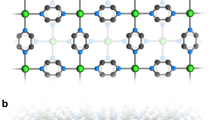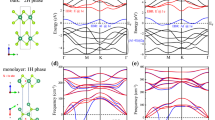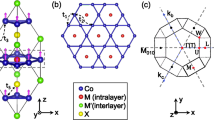Abstract
The discovery of a low-temperature superconducting state in organic compounds of the type (TMTSF)2CIO4 (Tc = 1.2 K) and (BEDT-TTF)2AuI2 (TC = 4 K) (where TMTSF is tetramethyltetraselenafulvalene, BEDT-TTF is bis(ethylenedithiolo)tetrathiafalvalene and Tc is the superconducting transition temperature) has stimulated the search for new materials that may show higher values of Tc (refs 1–3). The general problem encountered in molecular charge-transfer salts of this type, which have conduction bands formed by intermolecular overlap of π-electron systems, is that conduction is usually quasi-one-dimensional, with good conduction along the stacking direction. Metals with this one-dimensional character are unstable, and undergo a Peierls transition4 to a semiconducting state at low temperatures. The relatively few exceptions (mentioned above), which remain metallic down to low temperatures, are considered to do so because they show stronger interstack interactions. We report here a new material with inherently two-dimensional interactions between the molecular π-electron systems and which we are able to stabilize as a metal down to low temperatures (1.4 K) under hydrostatic pressure (12 kbar).
This is a preview of subscription content, access via your institution
Access options
Subscribe to this journal
Receive 51 print issues and online access
$199.00 per year
only $3.90 per issue
Buy this article
- Purchase on Springer Link
- Instant access to full article PDF
Prices may be subject to local taxes which are calculated during checkout
Similar content being viewed by others
References
Int. Conf. Synth. Metals, Kyoto, June 1986 Synth. Metals (in the press).
Williams, J. M. Prog. inorg. Chem. 33, 183–220 (1985).
Wudl, F. Acct. chem. Res. 17, 227–232 (1984).
Peierls, R. E. Quantum Theory of Solids 108–114 (Oxford University Press, London, 1955).
Underhill, A. E., Williams, J. M., Schultz, A. J. & Carneiro, K. in Extended Linear Chain Compounds Vol.1 (ed. Miller, J. S.) 73–118 (Plenum, New York, 1982).
Ahmad, M. M. et al. Phys. Rev. B29, 4796–4799 (1984).
Clemenson, P. I. et al. in Int. Conf. Synth. Metals, Kyoto, June 1986 Synth. Metals (in the press).
Guy, D. R. P. & Friend, R. H. J. Phys. E. 19, 430–433 (1986).
Friend, R. H. & Jerome, D. J. Phys. C 12, 1441–1477 (1980).
Author information
Authors and Affiliations
Rights and permissions
About this article
Cite this article
Parker, I., Friend, R., Clemenson, P. et al. A new low-dimensional metal, Cs[Pd(S2C2(CN)2)2]·0.5 H2O. Nature 324, 547–549 (1986). https://doi.org/10.1038/324547a0
Received:
Accepted:
Issue Date:
DOI: https://doi.org/10.1038/324547a0
This article is cited by
Comments
By submitting a comment you agree to abide by our Terms and Community Guidelines. If you find something abusive or that does not comply with our terms or guidelines please flag it as inappropriate.



